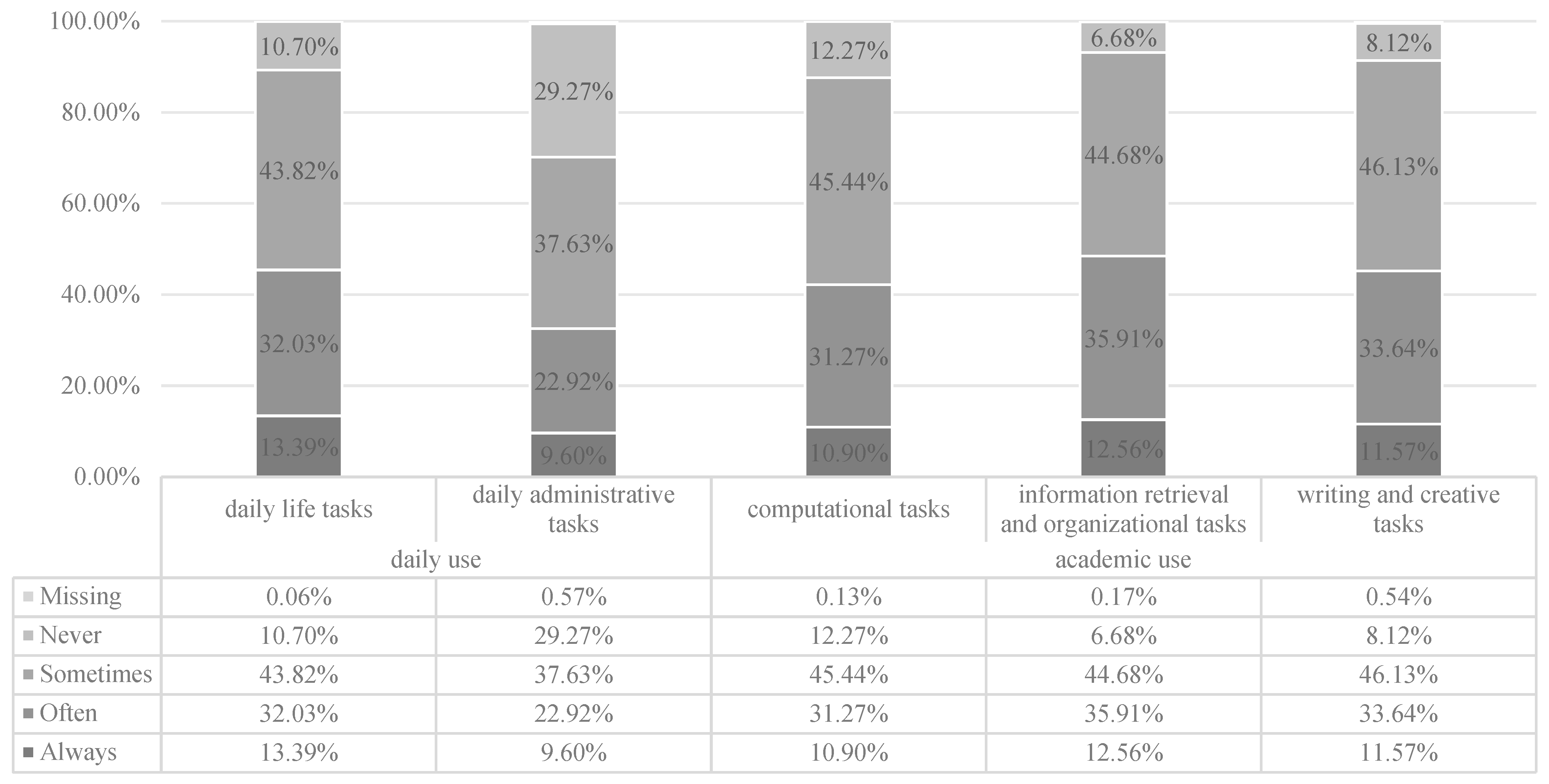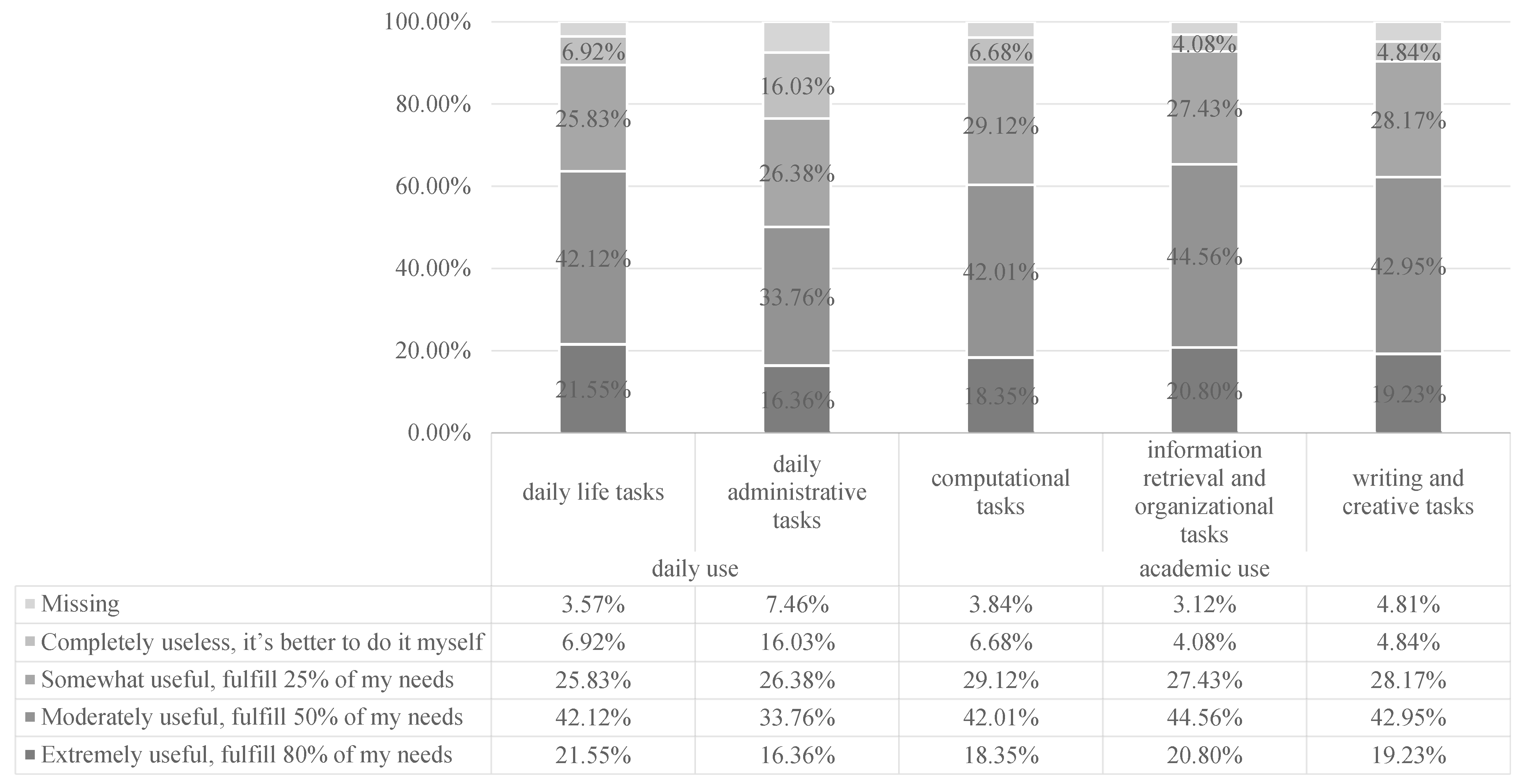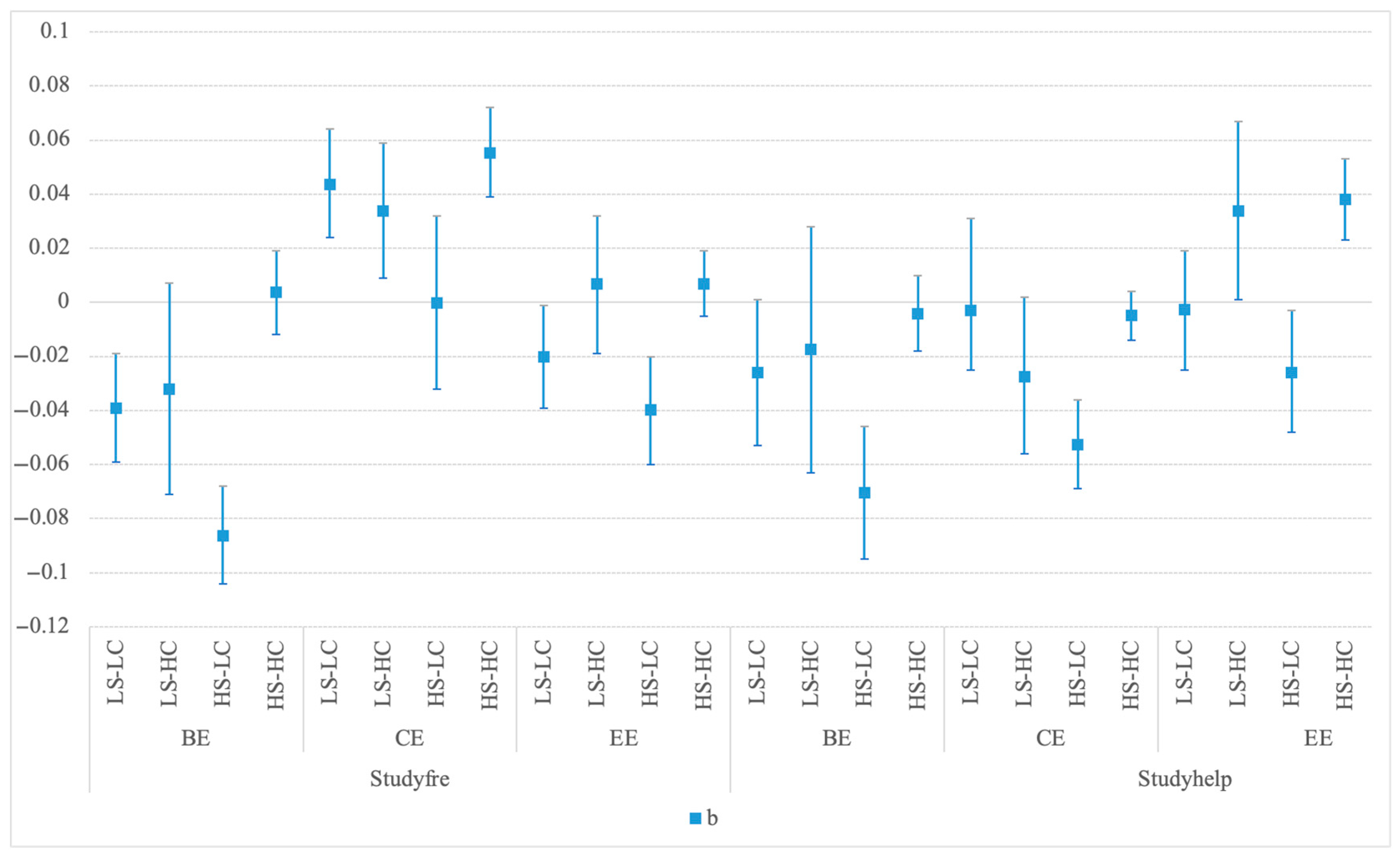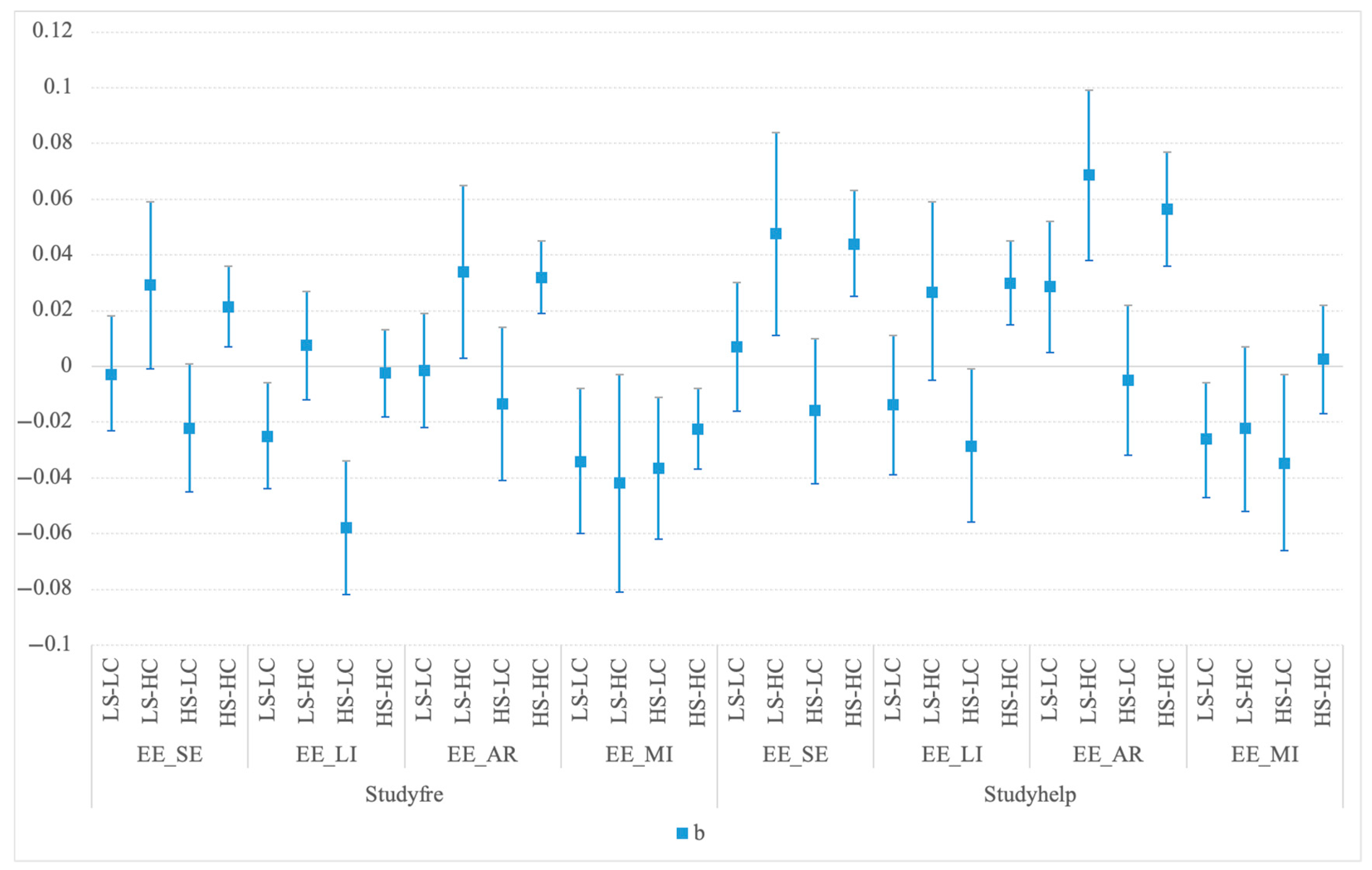Whether and When Could Generative AI Improve College Student Learning Engagement?
Abstract
1. Introduction
2. Theoretical Hypotheses
3. Method
3.1. Data and Sample
3.2. Variables
3.3. Models
4. Results
4.1. The Prevalence and Satisfaction of College Students Using GenAI
4.1.1. The Frequency of Using GenAI
4.1.2. Satisfaction with the Usefulness of GenAI
4.1.3. Academic Use of GenAI Across Different Learning Contexts
4.2. The Impacts of GenAI Use on Student Engagement
4.3. The Differences in the Relationship Between GenAI and Student Engagement Across Learning Contexts
5. Discussion and Conclusions
5.1. Summary of Findings
5.2. Discussion and Implications
Author Contributions
Funding
Institutional Review Board Statement
Informed Consent Statement
Data Availability Statement
Conflicts of Interest
Appendix A
| Variable | Definition and Measurement | M(SD)/% | Missing Rate (%) |
|---|---|---|---|
| Outcomes | |||
| BE | Behavioral engagement. Constructed with self-reported frequency of taking active learning behaviors, including concentrating on teacher’s lecture in class, taking notes in class, active participation in class discussion, on-time review and summarizing, etc. (6 items, Cronbach’s alpha = 0.91). | 67.23(22.01) | 0 |
| Continuous, scale: 1–100 | |||
| CE | Cognitive engagement. Constructed with self-reported frequency of taking integrative thinking, reflective thinking, and critical thinking behaviors in learning (9 items, Cronbach’s alpha = 0.95). | 68.22(21.16) | 0 |
| Continuous, scale: 1–100 | |||
| EE | Emotional engagement. Constructed with the arithmetic average of self-reported scores on EE_SE, EE_LI, EE_AR and EE_MII. | 69.63(17.56) | 0 |
| Continuous | |||
| EE_SE | Students’ beliefs in their own ability to gain academic achievements (3 items, Cronbach’s alpha = 0.85). | 69.51(19.93) | 0 |
| Continuous, scale: 1–100 | |||
| EE_LI | Learning interest (2 items, Cronbach’s alpha = 0.77). | 67.11(21.77) | 0 |
| Continuous, scale: 1–100 | |||
| EE_AR | The psychological resilience when faced with academic challenge and pressure (4 items, Cronbach’s alpha = 0.89). | 70.98(19.46) | 0 |
| Continuous, scale: 1–100 | |||
| EE_MI | The intensity of learning motivation measured by a 7-point Likert-scale item and transformed into a 100-point variable. | 70.90(22.43) | 0 |
| Continuous, scale: 1–100 | |||
| Key explanatory variables | |||
| AIuse | Whether has used GenAI | 64.47% | 0 |
| Binary: 1 = Yes, 0 = No. | |||
| Studyfre | Academic utilization frequency of GenAI. Constructed with the arithmetic average of utilization frequency of GenAI addressing with academic tasks, including computational tasks (e.g., coding, solving mathematical problems, analyzing data), information retrieval and synthesis (e.g., conducting literature reviews, organizing data), and writing or creative tasks (e.g., generating paper outlines, developing research proposals). (3 items, Cronbach’s alpha = 0.86). | 49.36(24.02) | 35.60 |
| Continuous, scale: 1–100 | |||
| Studyhelp | Academic help from GenAI. Constructed with the arithmetic average of perceived usefulness of GenAI addressing academic tasks (3 items, Cronbach’s alpha = 0.87). | 59.98(24.36) | 36.84 |
| Continuous, scale: 1–100 | |||
| Lifefre | Utilization frequency of GenAI in daily life. Constructed with the arithmetic average of utilization frequency of GenAI addressing with daily tasks, including managing everyday activities (e.g., searching for general information, planning travel itineraries) and handling administrative duties (e.g., completing forms, drafting standardized documents). (2 items, Cronbach’s alpha = 0.70). | 43.55(26.41) | 35.55 |
| Continuous, scale: 1–100 | |||
| Lifehelp | Help from GenAI in daily life. Constructed with the arithmetic average of perceived usefulness of GenAI addressing daily tasks (2 items, Cronbach’s alpha = 0.72). | 56.14(27.21) | 37.29 |
| Continuous, scale: 1–100 | |||
| Course type | The type of courses, measured by the level of support and challenge. Categorical: 1 = courses with low support and low challenge 2 = courses with low support and high challenge 3 = courses with high support and low challenge 4 = courses with high support and high challenge | 38.96% | 0 |
| 6.75% | |||
| 11.22% | |||
| 43.06% | |||
| Covariates | |||
| SD | Social desirability | 56.76(28.51) | 0 |
| Continuous scale: 1–100 | |||
| All variables shown in Table 1. (Repetition is omitted here.) | |||
| 1 | The Double World-Class Initiative, initiated in 2015, is a higher education development and sponsorship scheme of the Chinese central government. It is a highly selective elite university project recruiting only 147 out of 2820 regular HEIs by 2024, all of which are public-funded. |
| 2 | We used Confirmatory Factor Analysis (CFA) to examine the structural validity of the indicators. All indicators performed well. The results were reported in the CCSS 2024 Handbook and are available upon request. |
References
- Al-Maskari, A., Al Riyami, T., & Ghnimi, S. (2022). Factors affecting students’ preparedness for the fourth industrial revolution in higher education institutions. Journal of Applied Research in Higher Education, 16(1), 246–264. [Google Scholar] [CrossRef]
- Altbach, P. G., Reisberg, L., & Rumbley, L. E. (2019). Trends in global higher education: Tracking an academic revolution (Vol. 22). Brill. [Google Scholar]
- Ansari, A. N., Ahmad, S., & Bhutta, S. M. (2023). Mapping the global evidence around the use of ChatGPT in higher education: A systematic scoping review. Education and Information Technologies, 29, 1–41. [Google Scholar] [CrossRef]
- Baek, T., Tate, T., & Warschauer, M. (2024). “ChatGPT seems too good to be true”: College students’ use and perceptions of generative AI. Computer and Education: Artifical Intelligence, 7, 100294. [Google Scholar] [CrossRef]
- Bassner, P., Frankford, E., & Krusche, S. (2024, July 8–10). Iris: An ai-driven virtual tutor for computer science education. 2024 on Innovation and Technology in Computer Science Education V. 1 (pp. 394–400), Milan, Italy. [Google Scholar]
- Belda-Medina, J., & Kokošková, V. (2023). Integrating chatbots in education: Insights from the Chatbot-Human Interaction Satisfaction Model (CHISM). International Journal of Educational Technology in Higher Education, 20(1), 62. [Google Scholar] [CrossRef]
- Beveridge, L., Scott, G. G., & Terras, M. (2025). AI for good in HE? Leveraging AI and GenAI for note-taking and studying from lecture material. Journal of Inclusive Practice in Further and Higher Education, 17(1), 157–169. [Google Scholar]
- Carrell, S. E., & West, J. E. (2010). Does professor quality matter? Evidence from random assignment of students to professors. Journal of Political Economy, 118(3), 409–432. [Google Scholar] [CrossRef]
- Chiu, T. K. F. (2023). The impact of Generative AI (GenAI) on practices, policies and research direction in education: A case of ChatGPT and Midjourney. Interactive Learning Environments, 32(10), 6187–6203. [Google Scholar] [CrossRef]
- Coates, H. (2005). The value of student engagement for higher education quality assurance. Quality in Higher Education, 11(1), 25–36. [Google Scholar] [CrossRef]
- Cotton, D. R., Cotton, P. A., & Shipway, J. R. (2023). Chatting and cheating: Ensuring academic integrity in the era of ChatGPT. Innovations in Education & Teaching International, 61(2), 228–239. [Google Scholar]
- Essien, A., Bukoye, O. T., O’Dea, X., & Kremantzis, M. (2024). The influence of AI text generators on critical thinking skills in UK business schools. Studies in Higher Education, 49(5), 865–882. [Google Scholar] [CrossRef]
- Fredricks, J. A., Blumenfeld, P. C., & Paris, A. H. (2004). School engagement: Potential of the concept, state of the evidence. Review of Educational Research, 74(1), 59–109. [Google Scholar] [CrossRef]
- Gao, X., Guo, F., & Coates, H. (2022). Contributions to the field of student engagement and success. Higher Education Research & Development, 41(1), 62–74. [Google Scholar] [CrossRef]
- Guo, F., Zhao, L., & Lian, Z. (2018). Reliability of self-reported data in college student engagement surveys: Social desirability bias in self-reported survey. Journal of East China Normal, 36(04), 53–61+163. (In Chinese). [Google Scholar]
- Guo, S., Zheng, Y., & Zhai, X. (2024). Artificial intelligence in education research during 2013–2023: A review based on bibliometric analysis. Education and Information Technologies, 29(13), 16387–16409. [Google Scholar] [CrossRef]
- Habibi, A., Muhaimin, M., Danibao, B. K., Wibowo, Y. G., Wahyuni, S., & Octavia, A. (2023). ChatGPT in higher education learning: Acceptance and use. Computer and Education: Artifical Intelligence, 5, 100190. [Google Scholar] [CrossRef]
- Jones, M. P. (1996). Indicator and stratification methods for missing explanatory variables in multiple linear regression. Journal of the American statistical association, 91(433), 222–230. [Google Scholar] [CrossRef]
- Kahu, E. R. (2013). Framing student engagement in higher education. Studies in Higher Education, 38(5), 758–773. [Google Scholar] [CrossRef]
- Karp, M. M., & Bork, R. H. (2014). “They never told me what to expect, so I didn’t know what to do”: Defining and clarifying the role of a community college student. Teachers College Record, 116(4), 1–40. [Google Scholar] [CrossRef]
- Keuning, H., Alpizar-Chacon, I., Lykourentzou, I., Beehler, L., Köppe, C., de Jong, I., & Sosnovsky, S. (2024, November 12–17). Students’ perceptions and use of generative AI tools for programming across different computing courses. 24th Koli Calling International Conference on Computing Education Research (pp. 1–12), Koli, Finland. [Google Scholar]
- Koschmann, T. (1999, December 12–15). Toward a dialogic theory of learning: Bakhtin’s contribution to understanding learning in settings of collaboration. International Conference on Computer Supported Collaborative Learning, Palo Alto, CA, USA. [Google Scholar]
- Kuh, G. D., Kinzie, J., Buckley, J. A., Bridges, B. K., & Hayek, J. C. (2011). Piecing together the student success puzzle: Research, propositions, and recommendations: ASHE higher education report (Vol. 116). John Wiley & Sons. [Google Scholar]
- Kuh, G. D., Kinzie, J. L., Buckley, J. A., Bridges, B. K., & Hayek, J. C. (2006). What matters to student success: A review of the literature (Vol. 8). National Postsecondary Education Cooperative. [Google Scholar]
- Kwok, H. L., Shi, Y., Xu, H., Li, D., & Liu, K. (2025). GenAI as a translation assistant? A corpus-based study on lexical and syntactic complexity of GPT-Post-edited learner translation. System, 130, 103618. [Google Scholar] [CrossRef]
- Li, E. Y., & Jan, A. (2023, October 19–23). Impact of artificial intelligence (AI) in enhancing productivity and reducing stress among students. 2023 International Conference on Electronic Business (ICEB), Chiayi, Taiwan, China. Available online: https://aisel.aisnet.org/iceb2023/33 (accessed on 30 May 2025).
- Lin, C.-J., Lee, H.-Y., Wang, W.-S., Huang, Y.-M., & Wu, T.-T. (2024). Enhancing reflective thinking in stem education through experiential learning: The role of generative ai as a learning aid. Education and Information Technologies, 30(5), 6315–6337. [Google Scholar] [CrossRef]
- Ling, Z., & Junzhou, X. (2025). The paradox of self-efficacy and technological dependence: Unraveling generative AI’s impact on university students’ task completion. The Internet and Higher Education, 65, 100978. [Google Scholar]
- Min, C., Zhao, Y., Bu, Y., Ding, Y., & Wagner, C. S. (2023). Has China caught up to the us in AI research? An exploration of mimetic isomorphism as a model for late industrializers. arXiv, arXiv:2307.10198. [Google Scholar] [CrossRef]
- MOE (Ministry of Education of the People’s Republic of China). (2023). China’s higher education has entered a stage of popularization. Available online: http://www.moe.gov.cn/jyb_xwfb/s5147/202301/t20230111_1038961.html (accessed on 30 May 2025).
- Rahman, M. M., & Watanobe, Y. (2023). ChatGPT for education and research: Opportunities, threats, and strategies. Applied Sciences, 13(9), 5783. [Google Scholar] [CrossRef]
- Selwyn, N. (2016). Digital downsides: Exploring university students’ negative engagements with digital technology. Teaching in Higher Education, 21(8), 1006–1021. [Google Scholar] [CrossRef]
- Shi, J., Zhang, H., & Guo, F. (2024). Exploring the phenomenon of the Chinese learner and efforts in constructing original China educational knowledge: A fifteen-year case study of the China college student survey (CCSS) project. Journal of East China Normal University (Educational Sciences), 42(11), 12–29. (In Chinese). [Google Scholar]
- Smolansky, A., Cram, A., Raduescu, C., Zeivots, S., Huber, E., & Kizilcec, R. F. (2023, July 20–22). Educator and student perspectives on the impact of generative AI on assessments in higher education. Tenth ACM Conference on Learning@ Scale (pp. 378–382), Copenhagen, Denmark. [Google Scholar]
- Susnjak, T., & McIntosh, T. R. (2024). Chatgpt: The end of online exam integrity? Education Sciences, 14(6), 656. [Google Scholar] [CrossRef]
- Taft, S. H., Kesten, K., & El-Banna, M. M. (2019). One size does not fit all: Toward an evidence-based framework for determining online course enrollment sizes in higher education. Online Learning, 23(3), 188–233. [Google Scholar] [CrossRef]
- Tian, W., Ge, J., Zhao, Y., & Zheng, X. (2024). AI Chatbots in chinese higher education: Adoption, perception, and influence among graduate students—An integrated analysis utilizing UTAUT and ECM models. Frontiers in Psychology, 15, 1268549. [Google Scholar] [CrossRef] [PubMed]
- Trow, M. (2007). Reflections on the transition from elite to mass to universal access: Forms and phases of higher education in modern societies since WWII. In International handbook of higher education (pp. 243–280). Springer. [Google Scholar]
- Trowler, V. (2010). Student engagement literature review. The Higher Education Academy, 11(1), 1–15. [Google Scholar]
- Wang, Wang, M., Xu, X., Yang, L., Cai, D., & Yin, M. (2023). Unleashing ChatGPT’s power: A case study on optimizing information retrieval in flipped classrooms via prompt engineering. IEEE Transactions on Learning Technologies, 17, 629–641. [Google Scholar] [CrossRef]
- Yan, L., Sha, L., Zhao, L., Li, Y., Martinez-Maldonado, R., Chen, G., Li, X., Jin, Y., & Gašević, D. (2023). Practical and ethical challenges of large language models in education: A systematic scoping review. British Journal of Educational Technology, 55(1), 90–112. [Google Scholar] [CrossRef]
- Zhao, Y., Pugh, K., Sheldon, S., & Byers, J. L. (2002). Conditions for classroom technology innovations. Teachers College Record, 104(3), 482–515. [Google Scholar] [CrossRef]
- Zhou, B. (2019). From scale to quality: Experiences and challenges in teacher education in China. ECNU Review of Education, 2(2), 196–204. [Google Scholar] [CrossRef]




| Variable | Definition and Measurement | M(SD)/% | Missing Rate (%) |
|---|---|---|---|
| Female | Gender. Binary: 1 = Female, | 47.80% | 0 |
| 0 = Male. | 52.20% | ||
| Ethnic minority | Ethnicity. Binary: 1 = Ethnic Minority, | 8.51% | 0 |
| 0 = Han. | 91.49% | ||
| Urban | Living region. Binary: 1 = Urban, | 73.36% | 0 |
| 0 = Rural. | 26.54% | ||
| SES | Socio-Economic Status of family. Constructed with self-reported family income, educational level and career of parents by factor analysis. Continuous. | −0.03(0.98) | 1.23 |
| GKScore | Standardized GaoKao score by province, exam year, and examination type. Continuous. | 0.06(0.96) | 2.37 |
| DWC | Study in Double World-Class (DWC) HEIs. Binary: 1 = yes, 0 = no. | 61.13% | 0 |
| 39.87% | |||
| Grade | Year in college Categorical: 1–4 = year 1–4. | 31.84% | 0 |
| 27.13% | |||
| 23.84% | |||
| 17.20% | |||
| Major area | Area of an academic major in college. Categorical: 1 = Humanities, | 9.23% | 0 |
| 2 = Social sciences, | 34.51% | ||
| 3 = Sciences, | 10.24% | ||
| 4 = Engineering (not computer science), | 35.51% | ||
| 5 = Engineering (computer science). | 10.52% |
| Variable | M (SD) of z-Score | ANOVA Test F-Value | Bonferroni Post-Hoc Test | |||
|---|---|---|---|---|---|---|
| 1 Low-Support and Low-Challenge | 2 Low-Support and High-Challenge | 3 High-Support and Low-Challenge | 4 High-Support and High-Challenge | |||
| Studyfre | −0.12 (0.86) | 0.10 (1.02) | −0.15 (0.92) | 0.13 (1.11) | 251.89 *** | 4 = 2 > 1 = 3 |
| Studyhelp | −0.17 (0.89) | 0.02 (0.98) | −0.07 (0.96) | 0.17 (1.08) | 380.34 *** | 4 > 2 > 3 > 1 |
| BE | CE | EE | EE_SE | EE_LI | EE_AR | EE_MI | |
|---|---|---|---|---|---|---|---|
| b/se | b/se | b/se | b/se | b/se | b/se | b/se | |
| Panel 1. The overall use of GenAI | |||||||
| AIuse | −0.0073 | 0.0559 *** | 0.0266 ** | 0.0287 ** | 0.0205 | 0.0345 ** | 0.0080 |
| (0.0086) | (0.0082) | (0.0083) | (0.0087) | (0.0099) | (0.0101) | (0.0093) | |
| N | 72,615 | 72,615 | 72,615 | 72,615 | 72,615 | 72,615 | 72,615 |
| R-squared | 0.3506 | 0.3949 | 0.3084 | 0.2595 | 0.2512 | 0.2522 | 0.1442 |
| Panel 2. The frequency and satisfaction of GenAI in different settings | |||||||
| Studyfre | −0.0214 ** | 0.0444 *** | −0.0061 | 0.0100 | −0.0143 * | 0.0171 ** | −0.0291 *** |
| (0.0058) | (0.0064) | (0.0039) | (0.0055) | (0.0054) | (0.0045) | (0.0062) | |
| Studyhelp | −0.0194 ** | −0.0090 | 0.0174 * | 0.0255 ** | 0.0088 | 0.0416*** | −0.0128 |
| (0.0064) | (0.0064) | (0.0080) | (0.0089) | (0.0078) | (0.0092) | (0.0076) | |
| Lifefre | 0.0889 *** | 0.0381 *** | 0.0720 *** | 0.0587 *** | 0.0967 *** | 0.0257** | 0.0572 *** |
| (0.0070) | (0.0059) | (0.0080) | (0.0085) | (0.0076) | (0.0083) | (0.0075) | |
| Lifehelp | 0.0289 *** | 0.0252 *** | 0.0645 *** | 0.0643 *** | 0.0650 *** | 0.0520 *** | 0.0367 *** |
| (0.0071) | (0.0044) | (0.0073) | (0.0074) | (0.0069) | (0.0082) | (0.0072) | |
| N | 45,368 | 45,368 | 45,368 | 45,368 | 45,368 | 45,368 | 45,368 |
| R-squared | 0.3582 | 0.3990 | 0.3236 | 0.2756 | 0.2725 | 0.2601 | 0.1462 |
| BE | CE | EE | EE_SE | EE_LI | EE_AR | EE_MI | |
|---|---|---|---|---|---|---|---|
| 1. Ever used GenAI | 0 | + | + | + | 0 | + | 0 |
| 2. GenAI use in academic settings | −/− | +/0 | 0/+ | 0/+ | −/0 | +/+ | −/0 |
| 3. In different learning contexts | |||||||
| Low-support and low-challenge | −/0 | +/0 | −/0 | 0/0 | −/0 | 0/+ | −/− |
| Low-support and high-challenge | 0/0 | +/0 | 0/+ | 0/+ | 0/0 | +/+ | −/0 |
| High-support and low-challenge | −/− | 0/− | −/− | 0/0 | −/− | 0/0 | −/− |
| High-support and high-challenge | 0/0 | +/0 | 0/+ | +/+ | 0/+ | +/+ | −/0 |
Disclaimer/Publisher’s Note: The statements, opinions and data contained in all publications are solely those of the individual author(s) and contributor(s) and not of MDPI and/or the editor(s). MDPI and/or the editor(s) disclaim responsibility for any injury to people or property resulting from any ideas, methods, instructions or products referred to in the content. |
© 2025 by the authors. Licensee MDPI, Basel, Switzerland. This article is an open access article distributed under the terms and conditions of the Creative Commons Attribution (CC BY) license (https://creativecommons.org/licenses/by/4.0/).
Share and Cite
Guo, F.; Zhang, L.; Shi, T.; Coates, H. Whether and When Could Generative AI Improve College Student Learning Engagement? Behav. Sci. 2025, 15, 1011. https://doi.org/10.3390/bs15081011
Guo F, Zhang L, Shi T, Coates H. Whether and When Could Generative AI Improve College Student Learning Engagement? Behavioral Sciences. 2025; 15(8):1011. https://doi.org/10.3390/bs15081011
Chicago/Turabian StyleGuo, Fei, Lanwen Zhang, Tianle Shi, and Hamish Coates. 2025. "Whether and When Could Generative AI Improve College Student Learning Engagement?" Behavioral Sciences 15, no. 8: 1011. https://doi.org/10.3390/bs15081011
APA StyleGuo, F., Zhang, L., Shi, T., & Coates, H. (2025). Whether and When Could Generative AI Improve College Student Learning Engagement? Behavioral Sciences, 15(8), 1011. https://doi.org/10.3390/bs15081011






